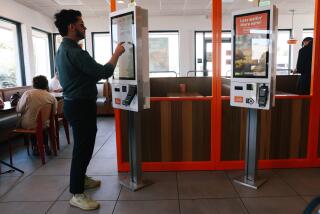Voice Processing Lets Computers Do the Work : Technology: Point-to-Point Concept Communications has sold its phone systems to retailers, real estate brokers, manufacturers and auto dealers.
SANTA ANA — For Bob Mock, Mondays used to mean staying within earshot of the phones until 71 different Red Lobster restaurants called his office with weekly sales reports.
For the senior vice president of Red Lobster’s West Coast operations, the once-a-week ordeal meant hours of interrupted work for him and his 12-person staff in Orange.
But last year, Mock hired Santa Ana-based Point-to-Point Concept Communications to install a voice-processing system, which left the mundane task of taking sales reports to a computer. Mock’s staff “now spends less than 50 minutes to retrieve this information,” he said.
Point-to-Point Concept has sold its phone systems to retailers, real estate brokers, manufacturers and auto dealers, including Buena Park-based House of Imports, one of the nation’s largest Mercedes-Benz dealers. Last year, the voice-processing equipment distributor sold nearly $1 million worth of computer hardware and software.
As more small- and medium-size companies cut costs, many turn to voice-processing systems to assume the duties of receptionists and secretaries, said Sandie Laird, owner of Point-to-Point, which employs five people.
These systems can screen and forward calls, take messages, receive orders from clients, or tell customers the shipping status of an order, she said.
Laird, 41, hadn’t always planned to start a business. She said she was content as an account executive for AT&T; until 1984, when deregulation forced the phone giant to spin off its 22 local operating companies and reorganize them into seven independent regional telephone companies.
The breakup affected more than 80 million U.S. telephone consumers, including thousands of small business owners who, unlike major corporations, could not afford to hire a telecommunications expert for their company’s telephone needs.
Laird worked on AT&T;’s small business customer hot line in Orange County, where she heard enough complaints to know that this was a business opportunity.
Beginning in 1986 as a consultant, Laird helped small businesses pick a suitable long distance carrier and showed them ways to save on phone bills. A year later, she expanded into selling voice automation services.
In the last three years, “the voice-processing system has become very popular amongst the large corporations, and it’s starting to become popular among small companies,” said Marc Ostrofsky, president of Voice Processing magazine, a monthly trade publication in Houston.
The average cost of a voice system for a small business is $20,000, which is comparable to a year’s salary for a full-time receptionist, he said. Many companies are letting computers sort out phone calls in order to free employees to do more important work. Some have even used the machines to replace their telephone operators, he said.
Ostrofsky estimates that there are fewer than 5% of small businesses in the nation that use the voice-processing system. It’s “not because it is expensive--after all it costs about the same to hire a receptionist--but because many small business owners are not aware of the many cost-saving applications,” he said.
The voice-processing technology industry is considered one of the fastest-growing industries in the nation, Ostrofsky said. By the year 2000, he predicts that a vast majority of U.S. companies, large and small, will be using various forms of voice-processing systems.
To many new business owners, who often start out alone, the voice-processing equipment can add a bit of respectability to a fledgling business, Laird said. At times, the system can make a one-person company sound like a fair-size organization as recorded messages ask potential clients to direct their calls to various departments, she said.
At first, Laird said, it was tough to sell voice-processing systems to small business owners because many were not familiar with the technology. She has conducted dozens of educational seminars in Orange and Los Angeles counties.
There are many kinds of voice-processing equipment that meet different needs of small businesses. Laird’s advice for picking the right equipment is that companies buy voice-processing systems that are software-driven, which means they can be expanded through additional software enhancement. A company can keep the same hardware for the next five to 10 years, she said.
More to Read
Inside the business of entertainment
The Wide Shot brings you news, analysis and insights on everything from streaming wars to production — and what it all means for the future.
You may occasionally receive promotional content from the Los Angeles Times.








